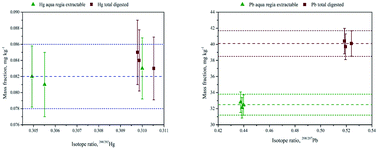A novel simultaneous isotope dilution strategy as a powerful tool in the two-track certification process of trace metal mass fractions: a case study of mercury, cadmium and lead in soil and sediment materials
Abstract
An analytical methodology based on isotope dilution (ID) principles was developed to establish the reference procedure for the simultaneous assignation of aqua regia extractable and total mass fractions of Hg, Cd, and Pb in soil and sediment matrix samples. The ‘twin sample-spike blends’ were prepared under close to the exact matching conditions, resulting in almost identical mass ratios of the spike to the sample in the blends, which followed either the aqua regia extraction method or total digestion procedure. The isotope ratios in ‘twin-blends’ were measured by inductively coupled plasma mass spectrometry (ICP-MS). The two-track IDMS strategy proposed in this work was successfully applied to three certified reference materials (CRMs): ERM-CC141 loam soil, EnvCRM 03 soil, and MODAS-2 bottom sediment. This ensured an adequate method validation. For two CRMs (EnvCRM 03 and MODAS-2) it was found that the isotope ratio values in ‘twin-blends’ for Hg, Cd, and Pb were almost identical with a variability of less than 2.4%. This confirmed that there is no measurable difference between the aqua regia extractable and the total mass fractions within the uncertainty ranges. Therefore, aqua regia mass fractions assigned in this study were found to be equal to certified element contents. For ERM-CC141 loam soil, the Hg isotope ratio values measured in the ‘twin-blends’ were found to be identical within their measurement uncertainties, and thus, it was concluded that the aqua regia extractable Hg content is identical to the total Hg content. However, in the case of Cd and Pb isotope ratio values in ‘twin-blends’ varied around 24% or 16%, respectively and because this significant difference was noticed, for both elements it is necessary to calculate the aqua regia content and the total content separately. Because this significant difference was noticed for both elements, it is necessary to calculate the aqua regia content and the total content separately. A detailed comparison of the isotope ratio values between the ‘twin-blends’ provided unambiguous information about aqua regia extractability of metals and it is a strong indicator for making decisions related to the assignment of either a single mass fraction valid for both procedures or two separate element mass fraction values. To our knowledge and based on the relevant literature survey, this is a novel strategy based on IDMS, and such studies have not been undertaken and presented so far.

- This article is part of the themed collection: Analytical Methods HOT Articles 2022


 Please wait while we load your content...
Please wait while we load your content...